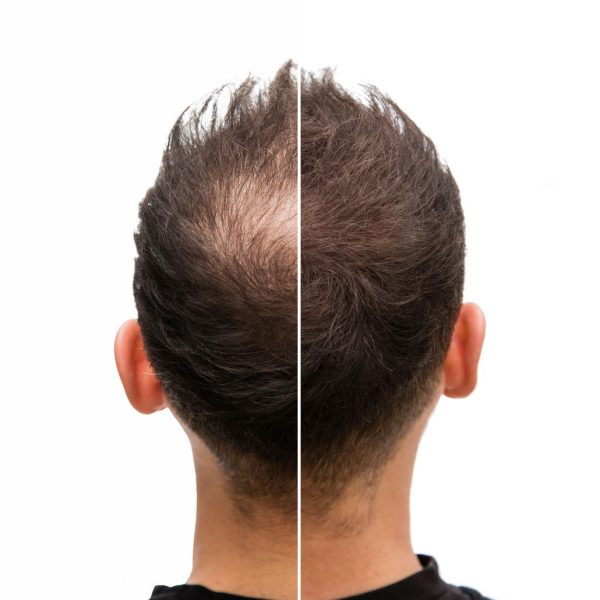PRP FOR HAIR GROWTH

About Androgenic Hair loss
male or female pattern hair loss
PRP for Hair Growth
Platelet-Rich Plasma (PRP) therapy is a cutting-edge treatment for hair growth that leverages the body’s natural healing processes.
The procedure begins by drawing a small amount of the patient’s blood, which is then spun in a centrifuge to separate the platelets and plasma from other components. These concentrated platelets, rich in growth factors, are then injected into the scalp where hair thinning or loss is occurring. The growth factors in PRP stimulate hair follicles, promoting new hair growth and thickening existing hair.
Over time, PRP treatments can help restore hair density, improve hair strength, and reduce hair loss, making it an effective solution for individuals struggling with thinning hair. Additionally, these growth factors force the hairs from the resting phase or telogen phase into the growth phase or anagen phase.
Treatment Process
A Step-by-Step Guide
Once we have agreed that PRP is an appropriate treatment for you this is what you need to expect.
First, a small amount of blood will be drawn from your arm using a butterfly needle, a simple and quick process.
Next, the drawn blood will be spun in a centrifuge to separate the platelet-rich plasma (PRP), which contains growth factors essential for stimulating hair follicles.
Then, the PRP is carefully injected into areas of thinning or balding scalp, targeting hair follicles to promote natural hair growth.
After the treatment, you’ll receive guidelines on post-care practices to ensure optimal results. Hair growth typically begins to show improvement after a few weeks.

PRP Hairgrowth Experience
Hair Growth Benefits of PRP Therapy
PRP therapy offers numerous benefits, including:
- PRP uses your body’s own platelets to naturally promote hair follicle activity, encouraging regrowth without invasive surgery
- Over time, PRP helps increase the thickness and volume of hair, creating a fuller and healthier appearance.
- Regular PRP treatments can enhance the health of your scalp and follicles, promoting sustained hair growth over time.
What to Expect After PRP for Hair Loss
While PRP therapy is generally safe and effective, some potential drawbacks include:
- Results become visible over several months, as the treatment stimulates natural growth, with the full effect usually visible within 6-12 months.
- Most patients can return to their normal activities immediately after treatment, making PRP a convenient option for busy lifestyles.
- With ongoing maintenance sessions, PRP helps maintain hair growth and prevent further loss.
Ideal Candidate
- Individuals experiencing thinning or early hair loss benefit most from PRP, as it helps reverse mild hair thinning.
- PRP supports healing and growth following a hair transplant, boosting success rates and improving results.
- PRP is highly effective for both male and female pattern baldness, offering a non-surgical solution.
Advantages of PRP for Hair Loss
- Unlike surgical hair restoration, PRP is a minimally invasive treatment with little to no discomfort.
- Since PRP uses your own blood, the risk of allergic reactions or complications is significantly reduced.
- Over time, PRP treatment can significantly improve hair density, providing a fuller, thicker appearance.
DOS AND DONTS
Guidelines for Pre- and Post-Procedure Care
Before
- Ensure you have a light meal and drink plenty of water on the day of your treatment to maintain hydration and energy levels.
- Cleanse your hair thoroughly the morning of your PRP session or at least the day before to keep the treatment area clean.
- Arrive at your appointment with clean, product-free hair to ensure the scalp is ready for treatment.
- If you need to cancel or reschedule, please do so at least 2 business days in advance to avoid a cancellation fee.
- Do not take NSAID medications like aspirin, Advil, or Motrin 7 days prior to your treatment to prevent excessive bruising.
- Refrain from consuming alcohol for at least 72 hours before your treatment for optimal results.
- Refrain from taking blood-thinning agents like vitamin E, fish oils, and garlic supplements a week prior to the procedure.
After
- Continue to drink plenty of water post-treatment to support your body’s natural healing process.
- Use ice packs on any areas of swelling or discomfort for 10-15 minutes every few hours to reduce inflammation.
- Rest with your head slightly elevated to reduce swelling or discomfort overnight.
- Do not take NSAIDs such as Advil, Motrin, or Aleve for 7 days after your treatment to allow for proper healing.
- Refrain from drinking alcohol for 72 hours following your treatment for better recovery.
- Continue to avoid blood-thinning agents for 48 hours post-treatment to reduce the risk of bruising.
- Avoid heavy exercise or strenuous physical activity for 24 hours to help the body heal properly.
- Steer clear of hot yoga, saunas, and direct sun exposure for 3 days to prevent irritation to the treated area.
- Refrain from washing your hair or showering for at least 24 hours post-treatment to allow the PRP to settle effectively.
- Mild bruising or swelling around the injection site may occur and should resolve within 72 hours. If discomfort persists, apply ice and consult your provider.
FAQ
Have a Question
Most patients experience mild swelling or soreness for a few days. The healing process typically begins after 4-6 weeks, with full benefits visible after several months.
Yes, PRP therapy is completely safe as it uses your own blood, reducing the risk of allergic reactions or infections.
This varies based on the condition being treated. Some patients experience improvement after one session, while others may need multiple sessions for optimal results.
Results from PRP can vary, but most clients begin to see improvement after 3-6 months, with continued improvements over time
